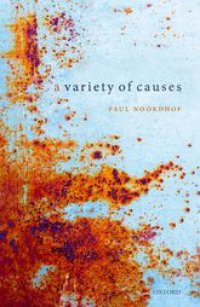
Ebook: A Variety of Causes
Author: Paul Noordhof
- Genre: Other Social Sciences // Philosophy
- Tags: causation counterfactual laws chance agency processes necessity
- Year: 2020
- Publisher: Oxford University Press
- Language: English
- pdf
This is the first book length defence of a counterfactual theory of causation. The analysis defended is new. It expresses the idea that, independent of its competitors, a cause raises the chance of an effect over its mean background chance by a complete causal chain. The analysis depends upon a novel development of David Lewis's Theory of Counterfactuals. One consequence of the analysis is that causation is not transitive. Causation is also nonsymmetric. The counterfactual basis of causal nonsymmetry is the result of a number of different, and sometimes interacting, nonsymmetries. The analysis allows for the development of a novel theory of events whose nature is independent of their role in causation and the identification of one other important causal relationship: property causation. Although compatible with Hume's denial of necessary connections between distinct existences, a key feature of the theory is that it benefits from being independent of the Humean framework. There are two ways in which something may be metaphysically fundamental: vertically and horizontally. Many metaphysicians emphasise vertical fundamentality and focus on truth making. The book rejects this emphasis and the truth making approach in particular. Horizontally fundamental metaphysical entities are those that are necessary components in different possible universes. Causation has a claim to be horizontally fundamental: the cement of any universe. Laws are patterns of causation realised in different metaphysical frameworks such as those articulated by Lewis, Armstrong and the powers ontologists. The book recognises varieties of causation both in, for example, counting cases of double prevention and causation by genuine processes as types of causation, and allowing that the analysis identifies causes across these different metaphysical frameworks.
Metaphysicians often focus on what is vertically fundamental, appealing to grounding or truth-making, rather than what is horizontally fundamental: what must be common to any metaphysical picture of the universe. There is a case for causation being one such feature. But how should it be characterized? A revised semantics for counterfactuals provides the basis for a new counterfactual analysis of causation that is compatible with Humean supervenience but also appropriate for a non-Humean metaphysical framework. Causes (independently of their competitors) both make the chance of an effect very much greater than its mean background chance in the circumstances and actually influences the probability of the effect in this way at the time at which the effect occurred via a complete causal chain. Causation understood in this way is a non-transitive relation. It is neutral over the metaphysics of causes and effects but allows a natural way for events to be understood as one fundamental type of causation, the other being property causation. Although negative causal statements are true, there are no cases of negative causation. The analysis explains how causation involving substantial processes is only one variety of causation, others include double prevention. It allows for a variety of micro- and macro-properties to be the basis of the difference between cause and effect. Laws are patterns of causation realized in different ways in different metaphysical pictures. The analysis of causation characterizes a horizontally fundamental property whose modal character depends upon its different realizations.
Metaphysicians often focus on what is vertically fundamental, appealing to grounding or truth-making, rather than what is horizontally fundamental: what must be common to any metaphysical picture of the universe. There is a case for causation being one such feature. But how should it be characterized? A revised semantics for counterfactuals provides the basis for a new counterfactual analysis of causation that is compatible with Humean supervenience but also appropriate for a non-Humean metaphysical framework. Causes (independently of their competitors) both make the chance of an effect very much greater than its mean background chance in the circumstances and actually influences the probability of the effect in this way at the time at which the effect occurred via a complete causal chain. Causation understood in this way is a non-transitive relation. It is neutral over the metaphysics of causes and effects but allows a natural way for events to be understood as one fundamental type of causation, the other being property causation. Although negative causal statements are true, there are no cases of negative causation. The analysis explains how causation involving substantial processes is only one variety of causation, others include double prevention. It allows for a variety of micro- and macro-properties to be the basis of the difference between cause and effect. Laws are patterns of causation realized in different ways in different metaphysical pictures. The analysis of causation characterizes a horizontally fundamental property whose modal character depends upon its different realizations.
Download the book A Variety of Causes for free or read online
Continue reading on any device:

Last viewed books
Related books
{related-news}
Comments (0)